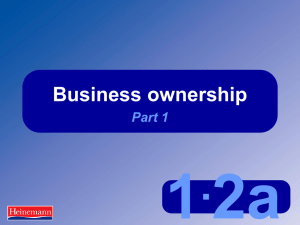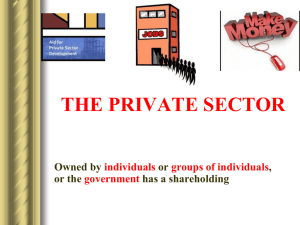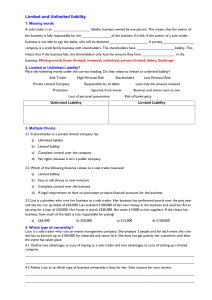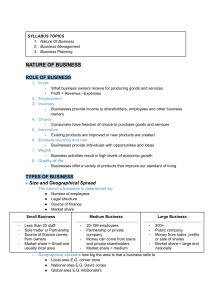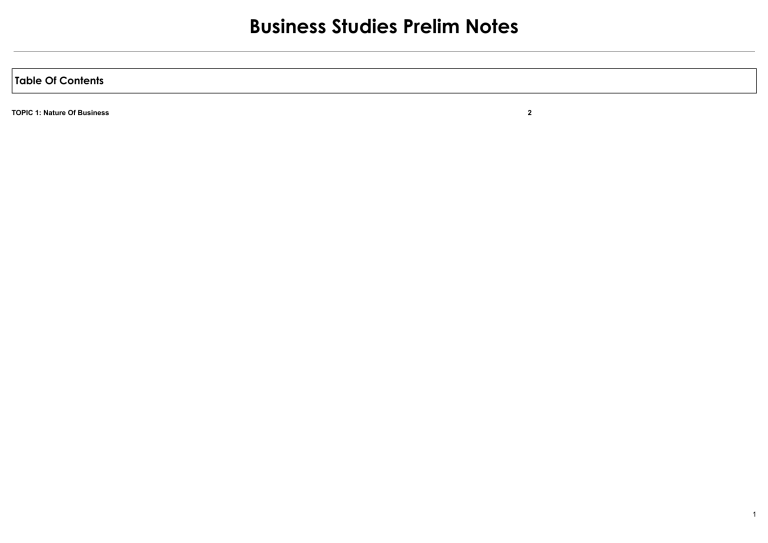
Business Studies Prelim Notes Table Of Contents TOPIC 1: Nature Of Business 2 1 TOPIC 1: Nature Of Business Role Of Business STUDENTS LEARN ABOUT NOTES • The nature of a business - Producing goods and services - Profit, employment, incomes, choice, innovation, entrepreneurship and risk, wealth and quality of life Business can be defined as: the organised effort of individuals to produce and sell, for a profit, products that satisfied consumers’ needs and wants. Businesses are what keep the economy running They sell different products which can be categorised into two groups 1. Goods - Are tangible → Can be touched and seen - E.g. woolworths sells fruits and vegetables 2. Services - Are intangible → Things done for us: an experience - E.g. when we go to the hairdresser or go in a taxi CASE STUDY EXAMPLES POSSIBLE QUESTIONS There are 7 other roles of businesses... 1. Profit: Money left over after all expenses have been deducted from the revenue - Revenue → Money you get from selling the products - Expenses → All the costs 2. Employment: Businesses employ people to work for them 3. Income: In return they get paid money for providing their time to make products 4. Choice: Businesses allow consumers to be able to choose the difference beaches quality and price of the products they want 5. Innovation: Businesses allow for new ideas 6. Entrepreneurship and risk: People can start and operate their own business 7. Wealth and quality of life: When we buy products we generally use them to make our lives easier and improve them Types Of Businesses STUDENTS LEARN ABOUT NOTES CASE STUDY EXAMPLES POSSIBLE QUESTIONS • Classification of business One of the ways businesses can be classified is by their size: - Size: small to medium 1. Micro enterprises (SMEs), large 2. Small - Local, national, global 3. Medium - Industry: primary, secondary, 4. Large tertiary, quaternary, quinary - Legal structure: sole trader, Businesses can also be classified by geographical spread: How big the area is that they sell to ? partnership, private company, 1. Local area public company, government - E.g a corner store enterprise 2. National area - E.g David Jones 3. Global area - E.g McDonalds Industry: A group of businesses that are involved in similar types of productions - E.g Fast food industry includes businesses such as KFC, McDonalds etc. All industries can be classified into 5 different categories 2 1. Primary industry: Production involves natural resources - E.g farming and mining - This industry is important because all materials used in other industries are sourced here 2. Secondary industry: Involves taking raw materials and turning them into products - E.g bakery takes flour from the primary industry which is used to make bread 3. Tertiary industry: Involves performing services for other people - E.g Retailers like grocery stores 4. Quaternary industry: Services that involve transferring and processing information and knowledge - E.g schools and banks 5. Quinary industry: Services that are performed in home - E.g childcare and hairdressing All businesses are one of the following two things: 1. Public business enterprises: Is owned by the government - Australia post - Railcorp transport 2. Private business enterprises: Is owned by private individuals - Local restaurants - Large businesses such as fast foods - There are four types of private business enterprises classified by legal structure: a. Sole trader: Owned and operated by one person - Make all decisions - Receive all profit - Have unlimited liability b. Partnership: Owned and operated by between 2-20 people - Shared workload - Unlimited liability c. Private company: Invite 2-50 people to be private shareholders - Private shareholder: Specific people that put money into a business in return for owning part of it - Limited liability - Easier to get finance d. Public company: Shares are offered to member of the public to purchase on exchanges - Limited liability - Easier to get finance - Have to publish financial reports for the public to see Liability = legal responsibility - Two different types of liability 1. Unlimited liability (unlimited responsibility): The business and owner are the same legal entity (they are not separate) - This means that the owner has full responsibility for all the debts of the business - If a business has unlimited liability, it is said that they are ‘unincorporated’ 2. Limited liability (limited responsibility): The business is legally separate from the owner - This means that the corporation itself is fully responsibility for the business debts - If a business has limited liability, it is said that they are ‘incorporated’ - Become a cooperation through the process of incorporation • Factors influencing choice of legal structure - Size, ownership, finance One of the choices that businesses have to make is what legal structure they should choose. Three factors influence this decision including: 1. Size of the business 3 - - As the business grows the type of legal structure the owner will choose changes Small business > The most ideal legal structures for small businesses are a sole trader or partnership Medium business > As the business gains popularity and production increases, it will become a medium business > Will require more money however more owners bring in extra money > They can be a partnership or private company Large business > As a range of stores open up in different areas, they will now be considered a large business > Will require more money > Will become a public company > To raise money from thousands of different shareholders = this is possible if the business decides to ‘float’ which means raising money through the sale of shares to the public on the ASX When businesses grow they require injections of money to fund the expansion. A way of gaining more money is getting more owners on board, which involves changing the legal structure. 2. The level of ownership they want - The legal structure can change depending on the level of control they want over the business > Complete control = sole trader > Shared control = choice between partnership or private company > Little control (control divided amongst thousands of shareholders - level control a person has is related to how many shares they own; if control is wanted to be kept, a person would have to own more than 50% of shares ) = public company 3. Source of finance - The type of finance a person gets can influence the type of legal structure they choose: - Sole Traders and partnership have unlimited liability which can be viewed as high risk for investors and banks - Since private companies and public companies have limited liability, this makes it easier to get finance form larger investors and banks - or they can raise money by selling shares > So majority of their finance is limited to their own savings and or small loans More importantly managers need to know when to change the legal structure Influences In The Business Environment STUDENTS LEARN ABOUT NOTES CASE STUDY EXAMPLES POSSIBLE QUESTIONS • External influences - Economic, financial, geographic, social, legal, political, institutional, technological, competitive situation, markets • Internal influences - Products, location, resources, management and business culture • Stakeholders 4 Business Growth & Decline STUDENTS LEARN ABOUT NOTES CASE STUDY EXAMPLES POSSIBLE QUESTIONS • Stages of the business life cycle - Establishment - Growth - Maturity - Post-maturity • Responding to challenges at each stage of the business life cycle • Factors that can contribute to business decline • Voluntary and involuntary cessation: liquidation TOPIC 2: Business Management The Nature Of Management STUDENTS LEARN ABOUT • Features of effective • Skills of management - Interpersonal, communication, strategic thinking, vision, problem-solving, decision-making, flexibility, adaptability to change, reconciling the conflicting interests of stakeholders NOTES CASE STUDY EXAMPLES POSSIBLE QUESTIONS ● A manager is someone who coordinates the business’ limited resources in order to achieve goals - Most important aspect of being a manager: coordinating what the business owns to achieve what they want ● This involves working with employees and using resources efficiently and effectively ● To achieve the above a manager needs to possess various skills Interpersonal skills Work and communicate with other people to understand their needs Communication Effectively expressing what you mean and listening to others - Verbal communication ● Emails, phone calls, conversations - Non-verbal communication ● Body language Strategic thinking ● The ability of the manager to see the broader picture Vision ● The shared sense of direction that allows people to achieve a common goal Problem solving ● Searching for different ways to solve an issue Decision making ● Choosing a solution Flexibility ● _______________________________________ 5 • Achieving business goals - Profits, market share, growth, share price, social, environmental - Achieving a mix of the above goals - Staff involvement innovation, motivation, mentoring, training Adaptability to change ● Being able to anticipate and adjust to change Reconciling the conflicting interests of stakeholders ● Stakeholder: anyone who is interesting or is affected by business activities ● Managers need to satisfy the both the stakeholders interest - Achieved through compromise and problem solving - One way to reconcile interests is through the process of ‘stakeholder engagement’: sharing information with stakeholders and asking for their opinions ● Goal: a desired outcome to be achieved within a certain time period ● Goals need to be ‘SMART’ - S: Specific - M: Measurable - A: Achievable - R: Realistic - T: Time bound ● Managers use these outlines to set financial, social and environmental goals MOST PREVALENT GOALS Financial ● Maximise profits ● Increase market share (percentage of the total sales in a market earned by a business) ● Maximize Growth (includes internal e.g. hire people and external e.g. merging or acquiring businesses) ● Improve share price - Business aim to increase the share price of the business and pay back healthy dividends to shareholders to show that the business is doing well - this also encourages people to invest in the business Social ● Community service - Businesses can support community events, education and welfare activities ● Providing employment - Hirer people from the local area to support the business Environmental ● Acting sustainably - Managers set goals allowing them to operate sustainably where they can meet the needs of people today without affecting future generations ACHIEVING A MIX OF GOALS ● Businesses attempt to achieve a mix of these goals because this will improve the overall success of the business - E.g. McDonald’s ● Use sustainable supply chains ● Sponsor athletic clubs ● Provide employment for people with disabilities STAFF INVOLVEMENT 6 Management Approaches STUDENTS LEARN ABOUT NOTES CASE STUDY EXAMPLES POSSIBLE QUESTIONS • Classical approach - Management as planning, organising and controlling - Hierarchical organisational structure - Autocratic leadership style • Behavioural approach - Management as leading, motivating, communicating - Teams - Participative/democratic leadership style • Contingency approach - Adapting to changing circumstances Management Process STUDENTS LEARN ABOUT NOTES CASE STUDY EXAMPLES POSSIBLE QUESTIONS • Coordinating key business functions and resources • Operations - Goods and/or services - The production process - Quality management • Marketing - Identification of the target market - Marketing mix • Finance - Cash flow statement - Income statement - Balance sheet • Human resources - Recruitment - Training - Employment contracts - Separation voluntary/involuntary • Ethical business behaviour 7 Management And Change STUDENTS LEARN ABOUT NOTES CASE STUDY EXAMPLES POSSIBLE QUESTIONS • Responding to internal and external influences • Managing change effectively - Identifying the need for change ● Business information systems - Setting achievable goals - Resistance to change - Management consultants 8


